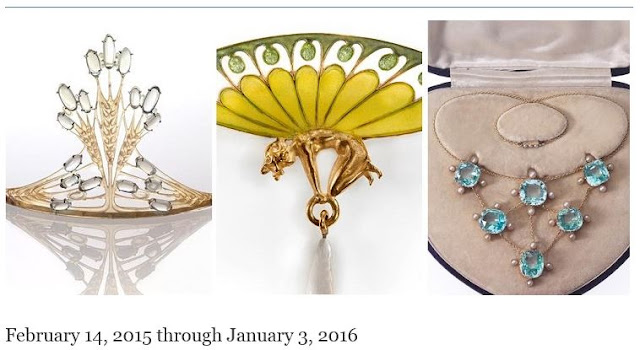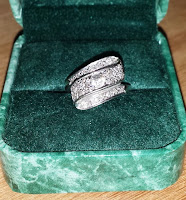 |
| Photo credit: The Driehaus Museum - Maker and Muse |
Not too long ago, I got a message from a friend of mine who was visiting family in Chicago - she wrote - "I went to a marvelous exhibit that included a section on jewelry, that was right up your alley. Brought home a brochure for you. Scoop for your blog?"
 |
| Photo credit: Nancy Barton |
When she returned to Austin, we caught up over coffee where she told me about her fabulous visit to the the Driehaus Museum in Chicago. Lucky woman - she had seen their Maker and Muse exhibit - which features more than two hundred and fifty pieces of jewelry created in the early decades of the twentieth century.
The exhibit runs through January 2016, and I'm trying to figure out how to get to Chicago to see it. In the mean time, I'm going to take advantage of the printed materials and the wonders of the internet to write about it.
 |
| Photo credit: Nancy Barton |
One of the things that makes this exhibit unique is that all of the pieces presented were made by women jewelers. The works featured are examples five areas of design and fabrication: the Arts and Crafts Movement in Britain, Art Nouveau in France and Belgium, Jugendstil in Germany and Austria, Louis Comfort Tiffany in New York, and American Arts and Crafts in Chicago.
These pieces are all from the British Arts and Crafts movement.
The opal and chalcedony dress clips (top, c. 1920) are the work of Sybil Dunlop, who worked in London during the first half of the 20th Century.
The bracelet (bottom, c. 1930) - in amethyst, citrine and peridot - was created by Dorrie Nossiter during the same period.
 |
| Photo credit: Nancy Barton |
This tiara (c.1900), which caught my friend's eye - but falls into the "can't imagine wearing that" category - was created by the firm of Child & Child. According to the exhibit brochure, they were well known for their elaborate enamel pieces featuring wing motifs.
I love the look of jewelry from this period - which includes works from Lalique and Tiffany (whose famous female designer Elsa Peretti is another of my favorites).

I am fortunate to have a few pieces of my own from the early 20th Century - including a fabulous Art Deco enameled ring (with a synthetic sapphire) and my grandmother's wedding ring - classic "bypass" style from the 1930s.
I also have some fabulous period reproduction pieces.
 One of my favorite custom jewelers, Yvonne Raley, also has a wonderful selection of Art Deco inspired pieces she designs. You can see the influence of this period in her work - including my latest purchase - a pair of "fan" earrings with lovely peach colored zircons. Yvonne creates new pieces from old designs both by creating castings from antique pieces, and working with a CAD (computer aided design) specialist to create new molds with a vintage feel.
One of my favorite custom jewelers, Yvonne Raley, also has a wonderful selection of Art Deco inspired pieces she designs. You can see the influence of this period in her work - including my latest purchase - a pair of "fan" earrings with lovely peach colored zircons. Yvonne creates new pieces from old designs both by creating castings from antique pieces, and working with a CAD (computer aided design) specialist to create new molds with a vintage feel. |
| Photo credit: Cecile Raley Designs |
The diamond filigree earrings from Russell Korman, (a great match to my birthday pendant from Green Gem) are another example of a contemporary piece in the style of this period. I love the detailed engraving and delicate petals on this pair.
It's wonderful to learn about women jewelry designers who were truly at the cutting edge of their industry, and I'm grateful to my friends for their encouragement on this blog.
Until next time.






















